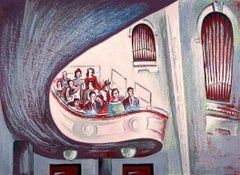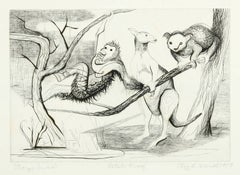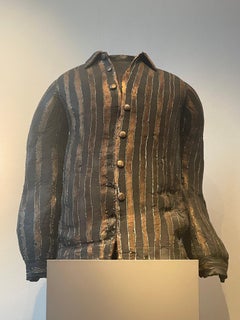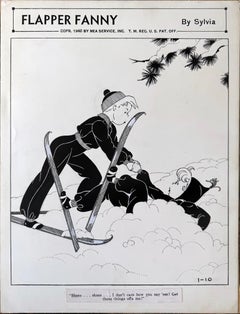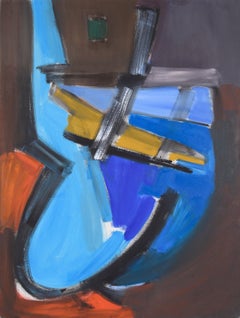Jim’s of Lambertville is proud to offer this artwork.
Signed and dated lower right.
Illustrated in "Charles Searles" 2013 exhibition catalog (La Salle University Art Museum / Tyler School of Art) pg. 195
Charles Searles (1937-2004)
He was born in Philadelphia, PA and received his fine art education at the Pennsylvania Academy of Fine Art (PAFA) from 1969-72. He also attended the University of Pennsylvania for liberal arts studies, where he worked in the labs beside the scientists and engineers creating technical illustrations for text books. His early paintings embraced the tumultuous 60's and also reflected his own family life and surroundings.
Before graduating the PAFA, Searles received the Cresson Memorial Traveling Scholarship, and the following year, the Ware Memorial Traveling Scholarship. He was the first student to use these funds to travel to Africa. His travels in Africa marked his life and work forever -- the life, the rhythms, the patterns, and the energy.
Searles returned to Philadelphia and began teaching at the Ile Ife Cultural Center. It was then that he began his "Dancer" Series. This series marked a change in his life, celebrating his new sense of renewal and the African experience. He was awarded his first mural commission at the William G. Green Federal Building. This work, entitled "Celebration" is still on view today. At that time, he was also hired as a drawing teacher at the (then) Philadelphia College of Art, where he remained a professor for over twenty years.
In 1978, Searles moved to New York City. He found a large, raw space -- an old sewing factory -- on Broadway and Bleeker where he would remain for the rest of his life. He continued to commute to Philadelphia teaching part time. He met Kathleen Spicer, an art student, in 1983. They married in 1985. Together, they shared a wonderful, open, artistic, social, and creative experience.
Searles gradually moved away from painting and into sculpture. His sculptures maintained the vibrant color and patterns from his paintings, but seemed to dance in three dimensions. These new works embodied a live sense of rhythm and energy -- trademarks that he maintained throughout his career, whether in wood, bronze, or aluminum.
In his lifetime, Charles Searles participated in over 60 group shows, and 25 solo exhibitions. He was represented by the Sande Webster Gallery in Philadelphia for over 20 years. His paintings and sculptures can be found in innumerable public and private collections. Public commissions include the Delaware River Port Authority, the NYC Mass Transit Authority, the First District Plaza in Philadelphia, and the Amtrak station in Newark, NJ. He was the recipient of many awards, including ones from the Pollock-Krasner Foundation, the Adolph and Esther Gottleib Foundation, the Creative Arts Project Fellowship, and the National Endowment for the Arts.
His wife of 23 years, Kathleen Spicer adds: "Charles was his work, and his work was him. Inseparable. Our lives were all about art. We lived each day as if it was a gift. To me, he was enchanted. His vision was clear -- he could envision something and make it come to life as easy as breathing. Genius. Charles made the world a better place. Charles speaks loud and clear."
Bio courtesy of Kathleen Spicer (Searles)
Selected Periodical Citations:
Newhall, Edith, "Dual Celebration of Self-expression", Philadelphia Enquirer, May 2013
Fabbri, Anne, "A Farewell to Charles Searles", Art Matters, January 2005
Cornell University Review, August 2000
O'Neill, Denise I., "Black Experience Puts Soul Into the Heart of Christmas", Chicago Sun-Times, December 1996
Gleuck, Grace, Review, The New York Times, December 1996
McBride, Octavia, "An Artist Acclaimed", Philadelphia Tribune, April 1993
Fox, Catherine, "National Black Arts Festival Program Guide", The Atlanta Journal, July 1990
Wilson, William, "Black Artists in Tune with Ancestors", Los Angeles Times, January 1990
Jamusch, Ann, "Special Show-Legacy of Black Art", Dallas Times Herald, January 1990
Binkley, Barbara, "Colors, Bright and Bold", The Daily News, April 1986
Grafly, Dorothy, "Charles Searles at Neumans", ART in Focus, Summer 1978
Crittendon, Denise, "Back Home from Nigeria", The Michigan Chronicle, December 1977
Garrett, Bob, Art Section Review. Boston Sunday Herald, November 1975
Patry, Louise, "A Jubilee of Afro-American Art in Boston", New England Journal, December 1975
Wright, Charles, "Paint Art Racist", The Village Voice, April 1971
Nelson, Nells, "Black Artists Rise Above the Tempest", Philadelphia Daily News, April 1971
Canaday, John, "Black Artist on View in Two Exhibitions", The New York Times, February 1970
Collections:
- Philadelphia Museum of Art
- The Woodmere Art Museum
- Smithsonian Institute of American Art
- Pennsylvania Academy of the Fine Arts
- LaSalle University Art Museum
- Howard University Gallery of Art
- Dallas Museum of Art
- Delaware Valley Arts Alliance
- Montclair Museum of Art
- Afro-American Historical & Cultural Museum
- Museum of Afro-American History
- 35 + corporate collections
- National & international private collections
75+ Group Exhibitions, Including:
- Woodmere Art Museum
- Pennsylvania Academy of the Fine Arts
- Whitney Museum of American Art
- Museum of American Art
- Boston Museum of Fine Arts
- Brooklyn Museum
- Art Alliance
- National Afro-American Museum
- Liberty Museum
- National Blacks Fine Arts Show
- Institute of Contemporary Art
- Ackland Arts Museum
- Arnot Art Museum
30+ Solo Exhibitions, Including:
- Philadelphia Museum of Art, Philadelphia PA
- The State Museum of Pennsylvania, Harrisburg, PA
- LaSalle University, Philadelphia, PA
- Temple University, Philadelphia, PA
- Montclair Art Museum, Montclair, NJ
- Noyes Museum, Oceanville, NJ
- Delaware Valley Arts Alliance, Narrowsburg, NY
- North Carolina State University
- Winston Salem State University, Winston Salem, NC
- G.R. N’Namdi Gallery, New York, NY
- Sande Webster Gallery, Philadelphia, PA
- June Kelly Gallery, New York, NY
- Noel Gallery, Charlotte, NC
-
Malcolm Brown...
